

BRIDGING FUNCTIONAL PERFORMANCE AND SHOW RING CRITERIA: CORRELATION OF LINEAR PHYSICAL TRAITS, PRODUCTIVE CAPACITY, AND SHOW RING ACHIEVEMENT IN U.S. DAIRY GOATS
Author: Katelyn Greene, 2025
Bachelors' in Agriculture Systems Capstone Research Project
Introduction:
A study conducted at Grande Ronde Dairy with the objective of quantifying the relationship between linear type traits and short-term milk yield in a commercial herd. The analysis extends to the ADGA National Show ring, comparing linear traits and production records among top-placing two-year-old does, to examine whether high productivity traits are recognized and rewarded in show placings.
Design and Measurements:
-
Evaluated 98 first and second-freshening does for linear traits, adhering to the ADGA Linear Appraisal (LA) SOPs
-
Traits scored: dairyness (DY), strength (STR), rump width (RW), fore udder attachment (FA), rear udder arch (RUA), rear udder height (RH), udder depth (UD), medial suspensory ligament (MS), and legs.
-
24-hour average (24 HR AV) milk yield recorded via parlor electronic milk meters
-
Statistical analyses: correlation, multiple regression, stepwise regression
-
-
Top 20 placing 2-year-old does from ADGA National Show (99 total) analyzed.
-
2-year-old LA scores and 305-day production records obtained from public databases.
-
-
Correlation analysis, scatterplots, and side-by-side comparisons of Top 5 vs. commercial herd averages.
-
Production normalized to breed standards (production-NBS).
-
Data standardized using group averages.

Table 1

Table 2

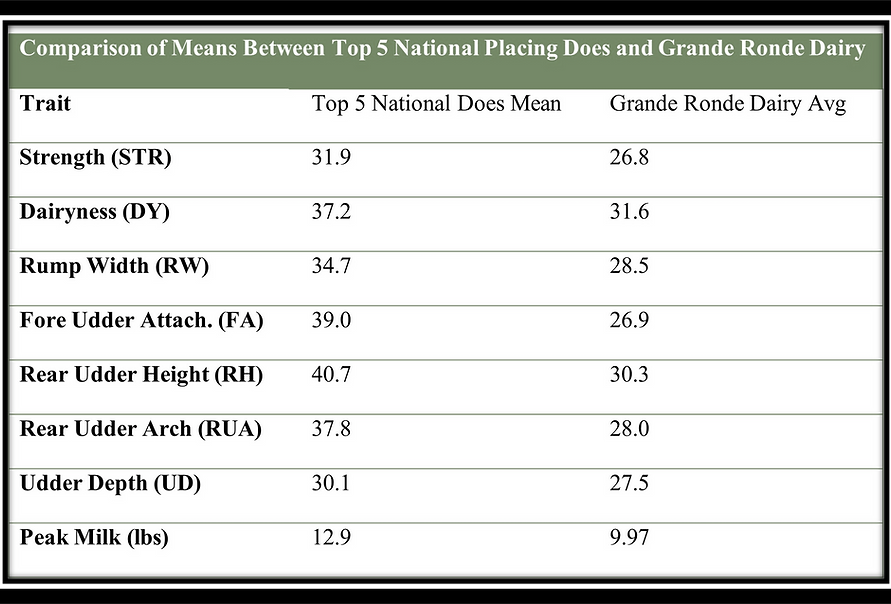
Table 3
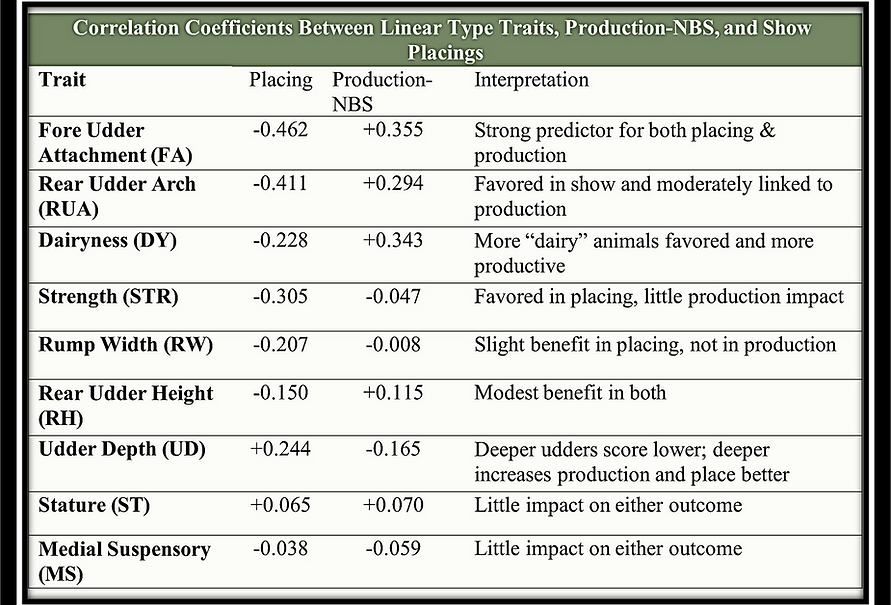
Table 4

Figure 1
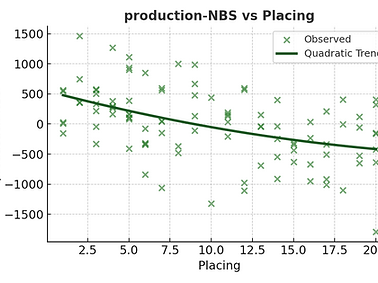
Figure 2

Figure 3

Figure 4
This is your Project description. Provide a brief summary to help visitors understand the context and background of your work. Click on "Edit Text" or double click on the text box to start.
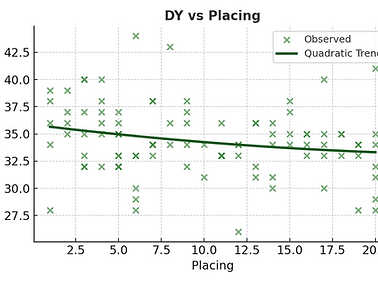
Figure 5
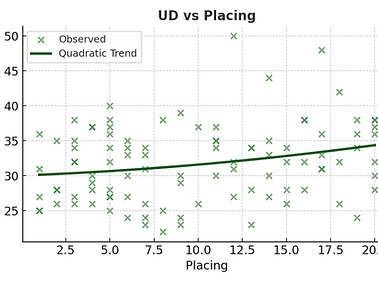
Figure 6
Key Results
-
Strongest predictors of 24 HR AV: FA, UD, DY (Table 1 & 2)
-
Stepwise regression with FA, UD, and DY explained approx. 38% 24 HR AV variance
-
One- point increase in FA (+0.137) , UD (-0.164), and DY (+0.144) results in +41.785, -50.02, and +43.92 lbs. milk per standard 305-day lactation
-
-
FA, RUA, DY, and Production-NBS showed moderate negative correlations with show placings (lower placing = higher ranking). (Fig. 1, 3, 5, 2, and Table 4)
-
Top placing does have substantially higher mean scores for udder-related traits and DY compared to commercial averages. (Table 3)
Industry Implications
-
This study confirms that current selection practices do advance functional, productive animals rather than simply emphasizing visual appeal.
-
Low LA and DHIA milk test participation (41.5%) of Top 20 animals raises the question: Are breeders committed to advancing productivity within the industry or are they primarily driven by the pursuit of competitive success?
-
Ongoing integration of performance testing will further align commercial and show sectors.
-
There is agreement between type traits recognized in the show ring with production and profitability in a commercial setting.
Acknowledgment
Special thanks to Stephanie Rovey, owner and operator of Grande Ronde Dairy in La
Grande, Oregon for her generosity in allowing me to access her animals and data records for my
capstone project. My sincere appreciation to my capstone advisor, Professor Raeder for his
guidance, expertise, and encouragement throughout every stage of this project.
Thank you to my family – parents, siblings, and grandparents- for their constant belief in
me and support. My deepest gratitude to my father for his invaluable industry insights and
tireless guidance throughout the course of this capstone project. His expertise and willingness to
share his knowledge were instrumental in shaping my understanding and approach to this work. I
am especially grateful for his encouragement and assistance, both of which have been crucial to
my success. Thank you to my mother, whose steadfast support, understanding, and inspiration
have been the foundation of my academic journey. Her strength and commitment have made all
accomplishments possible.
To my siblings – Emily, Bailey, Sarah, Katie, and Brady- who have been unwavering role
models, steadfast supporters, and, at times, my unofficial therapists throughout this journey.
Their examples have inspired me to strive for excellence and persevere in the face of challenges.
Whether through words of encouragement, thoughtful advice, or simply sharing in the daily joys
and challenges of life, my siblings have contributed immensely to my personal and academic
growth. To everyone who has offered support, insight, and reassurance along the way—thank
you. Lastly, to my daughter, it is because of you that I believed I could do it. It is for you that I
did.